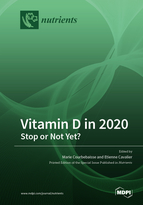Vitamin D in 2020: Stop or Not Yet?
A special issue of Nutrients (ISSN 2072-6643). This special issue belongs to the section "Micronutrients and Human Health".
Deadline for manuscript submissions: closed (31 July 2020) | Viewed by 50380
Special Issue Editors
Interests: mineral metabolism; nephrolithiasis; glomerular filtration rate measurement
Special Issues, Collections and Topics in MDPI journals
Special Issue Information
Dear Colleagues,
Many things have been said and written on the skeletal and nonskeletal effects of vitamin D, but the largest recent interventional studies are generally negative. How should we thus position ourselves in 2020? Should we say “stop” or “not yet”? Indeed, the aging of the population, but also new challenges and discoveries are still triggering interest in this old molecule.
In this Special Edition of Nutrients, we invite the finest experts to give their opinion on this important debate. We also encourage scientists to submit their latest research (original papers) and their reviews on nutritional request in the general population and in high-risk groups, such as among mobile societies, treatment strategies, optimal intakes and cut-offs, epidemiology, analytical updates and new devices for vitamin D measurement, bone and muscle health, kidney stones, cardiovascular diseases, diabetes mellitus, chronic kidney disease, infectious and auto-immune diseases, cancers, and pregnancy outcomes.
The scene is set, and the debate is open. Go to your keyboards!
Dr. Marie Courbebaisse
Prof. Dr. Etienne Cavalier
Guest Editors
Manuscript Submission Information
Manuscripts should be submitted online at www.mdpi.com by registering and logging in to this website. Once you are registered, click here to go to the submission form. Manuscripts can be submitted until the deadline. All submissions that pass pre-check are peer-reviewed. Accepted papers will be published continuously in the journal (as soon as accepted) and will be listed together on the special issue website. Research articles, review articles as well as short communications are invited. For planned papers, a title and short abstract (about 100 words) can be sent to the Editorial Office for announcement on this website.
Submitted manuscripts should not have been published previously, nor be under consideration for publication elsewhere (except conference proceedings papers). All manuscripts are thoroughly refereed through a single-blind peer-review process. A guide for authors and other relevant information for submission of manuscripts is available on the Instructions for Authors page. Nutrients is an international peer-reviewed open access semimonthly journal published by MDPI.
Please visit the Instructions for Authors page before submitting a manuscript. The Article Processing Charge (APC) for publication in this open access journal is 2900 CHF (Swiss Francs). Submitted papers should be well formatted and use good English. Authors may use MDPI's English editing service prior to publication or during author revisions.
Keywords
- Vitamin D
- Rickets
- Osteomalacia
- Osteoporosis
- Fall
- Cardiovascular diseases
- Diabetes mellitus
- Cancers
- Infectious diseases
- Auto-immune diseases
- Kidney stones
- Chronic kidney disease
- Pregnancy







